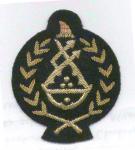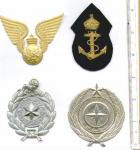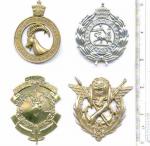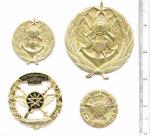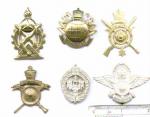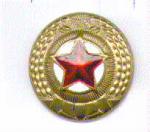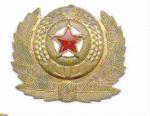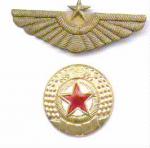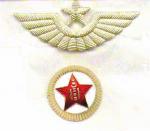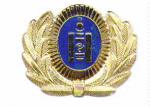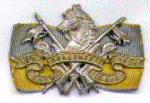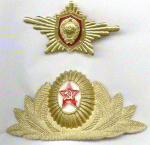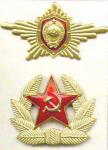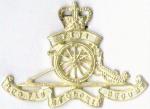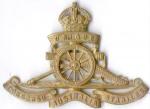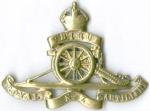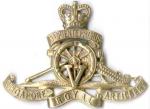
shako_uk
For Deletion-
Posts
90 -
Joined
-
Last visited
Content Type
Profiles
Forums
Blogs
Gallery
Events
Store
Everything posted by shako_uk
-
Iraqi AirForce Brigadier General Faisal I.D
shako_uk replied to a topic in Middle East & Arab States
What a wonderful collection of Iraqi material you have there! Thanks for displaying it. My own particular interest is in head-dress badges, but I was interested to note the symbols on the Iraqi Pilot's wings and brevet and I hope you may be able to clear a query for me. For some years, I have had an unidentified badge which bears similar symbols to those on your breast badges. Do you have any information that might link the Iraqi A/force with this badge? A scan is attached; the badge is 75mm high overall. If you can comment, I'd appreciate your thoughts and hope my inquiry will not be any inconvenience. Regards, Brian -
SAVC Artillery Cap badge
shako_uk replied to ra_collector's topic in Great Britain: Militaria: Badges, Uniforms & Equipment
Hi Simon, I was very interested in your Artillery badge and thank you for displaying it. Having said that, I do not think I can help with very much information, but can, perhaps, suggest a few leads. First, I do not think the badge is from Singapore. Currently, I believe, the Singapore Army has one General Service cap badge (and the old Singapore Volunteer Artillery badge carried its full title on the scroll). I suggest you look at the Shanghai Volunteer Corps, which had several different badges, though I have not come across an Artillery one, previously. You do not specify the size of your badge, but it looks very similar to the current Royal Malaysian Artillery badge, though the latter is about the size of the middle-sized Royal Artillery badge. The Malaysian badge does not have the SVC initials and the date. Sorry if this only complicates matters, but I shall be interested to hear how your inquiries go in the next few weeks - someone will, no doubt, be able to give chapter and verse! Regards, Brian -
Thanks for posting the illustration of the East Timor badge, Johnsy - this is the first information I have seen on badges of that country. The next step is to get one! I have been trying to get at least one badge from each country of the world, though the prospects are receding by the month. The position, at the moment, leaves me with, perhaps, half-a dozen countries to "conquer". However . . . "if at first you don't succeed . . . etc." Thanks again, Brian
-
Can anyone tell me whether the badge shown below is Turkish, please? I have had it for many years, without knowing its true identity. It is die-cast, in brass, 98mm high, with bend-over fasteners E-W. Obviously some naval connection, but, possibly coastal artillery? Thanks for any suggestions, in advance, Regards, Brian
-
Yugoslavia Yugoslavian cap badges
shako_uk replied to Bryan's topic in Southern European & Balkan States
My understaning of Yugoslavian badges is that the 1941-45 period was somewhat chaotic, as might be expected. There were two "armies" opposing the Germanns, one being essentially the rmnants of the old Yugoslav army and the second being the partisans under J. Broz Tito. When some semblancce of order was established, as regards inssignia on the Partisans, side,, badges were mainly cloth, cut from anything avvailable, a red star being the cap badge. The Royal Yugoslav forces which were organised in Britain wore the old Royal Yugoslav insignia. There was a badge designed for the Yugoslavs annd made in Britain, but I have never seen any pictures of this being worn, nor have I seen any reference to it in reference books. I do have a specimen of the badge, though! New badges were produced in the late 1940s, but thee were short-lived and the badges shown in my first scan were introduced. The badges with the hammer annd sickle emblem were worn by "Proletarian Troops" and the plain badges by other units. "Proletarian Troops", I gather, were those units which originated in the Proletarian Brigades and Divisions formed in the early years of theWW2 whose service and distinctions was commemorated by the wearing of the hammer and sickle on their badges. My first scan shows a selection of the red star badges in use from about 1950 until 1990, when a new rang of badges was introduced for. the Jugoslav National Army. My second scan shows two badges, I believe, of th late 1940s era, the Jugoslav crest being worn by Generals, but I do not know who wore the cockade. It is similar to the one already shown in this thread, but incorporates a wreath on the cockade and is made in three pieces (cokade, wreath overlay annd red eamelled star). I think this information is ccorrect, but am open to correction from anyone who has more concise dwtails available! -
Yugoslavia Yugoslavian cap badges
shako_uk replied to Bryan's topic in Southern European & Balkan States
You are correct, Leigh - your badge is from the Republic of Srpska and is a modern one. I have three different badges of this series - one like yours, one similar but with a half-wreath around the oval and one plain eagle. There are probably ten or a dozen different badges, but only half that number of designs, since some are in silver metal and some in gilt. So, your badge design appears in both metals. I don't know the reason for this, but someonne out there will probably tell us! Brian -
Conclusion: So, that's it, Stephen. I hope this will be of interest and, if you have anyinformation to offer, I'd be pleased to hear it. Brian
-
Continuation .... Two of the badges in the next scan are from the Imperial period and two from a later date. The one at top, left is really well-produced and is marked on the reverse "made in Ethiopia B.A.Sevadjian" Again, translations are necessary to identify these. More "modern" badges in this scan. I think the top two are from the Mengistu era, and both well-produsced, brass pressings. both the same design. The two on the bottom line are also similar, though the one to the left is die-struck, with screw-fastenings E-W. Officers and o/ranks? . . . . I don't know. Finally, I have an Imperial Air Force badge, Swedish-made and an Imperial Navy badge. I guess this Naval badge is that of a Petty Officer as opposed to a Commissioned Officer, but I have no further information. The two badges on the bottom line are, probably Police badges. Certainly, the inscription on the badge at the left reads: "Ethiopian Government Police" Continued below . . . .
-
Hope the attached scans will be of interest, Stephen. I'm sorry I do not knnow much about these items, but have tried to record what I know. The first scan shows Ethiopian Army badges from the 1950s. These are all cast brass and were the official issues. Some designs are obviously based on British b adges, for instance, the Medical Corps and the Electrical/Mechanical Engineers. The badge at the top tight is that of the Military School. The two on the bottom line, right, are both Infantry badges, don't know what the difference is. Presumably the inscriptions would help, had I a translator! The second scan shows some badges which were permitted, but had to be privately purchased. These are considerably smaller than the official issues and were made from brass pressings. The fasteners are thin, needle-like "sliders". Again, Medical, Artillery, Infantry and Transport are easily recognisable. The two on the left, bottom line, are exceptions, both being die-struck badges with screw fastenings. The one at the extreme left was made in Sweden and, despite its size, was the helmet badge of the Imperial Guard. The badge adjacent came to me at a later date and, due to the similarity, but lacking the Imperial Crown, I guess it may be the badge of the Presidential guard. I would stress that this is only surmise. The third scan shows more badges of the Imperial era, these rather better-made that the earlier ones, though the two at the bottom, right are both cast white-metal, The centre one being the badge of the Haile Selassie Military Academy. I don't think I have space for more scans so will start again.
-
I was interested in the remarks regarding North Korean badges and appreciate Reichrommel's comments. I was interested to learn that the second cap wings he showed is the civil airline. I have this badge, and had wondered why the difference between that and the military badge. The few oddments I have of North Korea are shown below. The first is the Army officer's cap cockade. Army Generals, in parade dress have gold wire-emboidered embellishments on the cap band, identical with the old Soviet custom. The second scan is that of the Air Force badge. Again, as with all the Soviet-orientated countries, the Air force is part of the army and flight personnel are distinguished by the cap wings above the army badge. This cockade, is slightly smaller than the Army officer's badge. The earlier (Korean War version was in plain brass with no enamelling. The Navy cockade is similar to the army one, but carried an anchor behind the star. (I do not have this one). The third scan, cockade in wreath, is, I guess, a more modern item. Anyone know who wears this? Brian
-
Mongolia Miscellaneous Militaria
shako_uk replied to Ed_Haynes's topic in People's Republic Mongolia
Two nice badges there, Ed. - thanks for showing them. I like the cap star particularly. The cockade is a police badge, I believe and, as such doesn't come into my field of collecting (though the dividing line is pretty thin in some instances! I thought you might like to see the Mongolian oddments I have. The first is the Army General's cap badge - officers used the cockade only, without the gilt metalwork. The dark cockade is merely the subdued version, probably worn by al ranks. My second is the badge of the Air Force, this being an earlier pattern, I think, which was superseded by the Soviet-inspired version shown in the third scan. I do believe the older version is again currently in use, but would like confirmation of this. The last scan shows the post 1992 Army badge for officers -
Thanks, Iffiq and Antonio Pietro, for your comments - most interesting and helpful, Brian
-
Is this classed as a "tinnie", or is it for civilian wear? Any information welcomed. This badge is 50mm across, bi-metal, mounted on a blue/yellow silk ribbon. It has a brooch-pin fastening, vertical, at the rear, on a circular plate marked "Paul Kust, Berlin C.19" The scroll reads: "VER. EHEM. DRAGONER 16 16. Aug. 1905"
-
I have had this badge for some time, now, though I am at a loss to know precisely what it is and how to classify it. The badge is stamped from thin metal, of a dark colour, though there could be traces of gilding on the flag. It is 45mm wide and has a rudimentary brooch pin fastening . It looks to be of German origin and it came to me as a badge manufactured by the Germans for Royal Marines prisoners of war. Has anyone come across this sort of thing before - does anyone have information that would confirm this background story or is it just another of those fables? As usual, any information will be appreciated, Brian
-
IOne of the goals I set myself, when opening up my collection world-wide, was to obtain at least one badge from each army, navy and air force of the world. Unfortunately, a few countries are most unco-operative and I feel doubtful that I shall ever reach my given target. However, hope springs eternal, and, even if I do not get the actual badges it would be nice to have illustrations of some of these elusive insignia. As far as North Africa is concerned, I have a reasonable representation, but I have never been able to find out anything about the cap badges worn by officers and other ranks of the Air Forces of Morocco and Algeria and, similarly, their Navy cap badges. Can any Gentleman supply me with illustrations of such things - scans, drawings, pencil rubbings, photos . . . anything! I would be grateful for any help. Brian
-
Albania Albanian Cap Star.
shako_uk replied to Belaruski's topic in Southern European & Balkan States
Thanks indeed, Belaruski! It will certainly fill a loing-standing gap if you can. Regards, Brian -
Thank you, all, for your very interesting replies to my queries. I find these two-part badges intriguing and a change from the badges incorporating a coloured National cockade, such as many of the South American states use. The states of the ex-Soviet Union seem to have followed this "secondary" badge trend, though I have found information, from those states, not easy to come by. I have a couple fo Soviet Honour Guard cap badges (scanned), from 1969, but I gather there was an additional pattern. This variation - if it was merely that - had a slightly different starburst and the centre carried the red star. I have only seen a picture of this badge (but not a photo!) and would be interested to know whether anyone can confirm its existence and, perhaps, explain why the variation from the more common (?) version.
-
Albania Albanian Cap Star.
shako_uk replied to Belaruski's topic in Southern European & Balkan States
A very nice badge, Belaruski, and one that made me slightly green around the gills for a while. Albania is the only country in Europe which is not represented in my collection . Strictly speaking that is not true, I suppose, for I do have a modern, cloth beret badge, but I am not a fan of cloth badges and much prefer sometthing metal and more substantial. However, despite my efforts in the past I have never been successful in acquiring a cap badge of either the pre-1940 period or the communist era. I've written to uncle Tom Cobley and all, iin my efforts, including embassies, the present Pretender and even his mother, Queen Geraldine. at one stage. all to no avail, but that's the collecting game, isn't it? I had seen this scan of your previously, but thanks for drawing my attention to it once again! Brian -
I omitted to mention, in the above notes regarding the star and wreath badge which is coupled with the pennant , that, on the dust jacket of Otto von Pivka's book, "The Armies of Europe Today", a badge very similar to this is shown being worn by a Soviet Army bandsman. Could it be that the beret was worn by bandsmen of a para unit? Just a thought . . . . Brian
-
Rather than confuse the "Cap Stars" thread, as, perhaps, I did recently, I thought it better to start another. The scans that follow show three more Soviet badges which are puzzling to say the least. Comments will be welcomed, as usual: The first shows a badge of the same design as the old Soviet Railway Troops collar insignia, but it was obviously a cap badge. Whilst the fasteners are missing, it was originally furnished with the standard "bend-over" strips used on cap/beret badges. The wingspan is 78mm. This badge came from South Africa and I was told it was "liberated" from Angola by a S. African soldier. True or not, I have not seen a similar one. The second pair of badges is more exotic and, as Belaruski says of the query I offered under "Cap Stars", it may be the product of someone's imagination. I leave you to judge and comment. The pair came to me mounted on a light-blue beret which had obviously had some use. The red star/wreath badge was first, with the pennant badge affixed to its right (or behind it if you are facing the wearer). The star/wreath badge is a concotion of a normal other-ranks badge and an officer's wide-wreath badge, 100mm wide. The Pennant badge looks to be hand-made, though well-produced. The pennant is cut from thin shhet brass, with a transucent red plastic overlay on which is mounted a standard Paratroops collar badge. The fixing is a single screw fastener, behind the para badge. Additionally, a needle-like extension at the exteme tip of the pennant ensures that it keeps position on the curve of the beret. The width of the badge is 130mm excluding the needle. Many thanks for your views on my previous query. Brian
-
I was under the impression that Soviet badges with screw fasteners were breast insignia and that cap badges had the thin "bend-over" strips or wires as fasteners. This from a Russian collector. A wonderful display of cap stars in the preceding scans - thank you for those, Gentlemen. I have a hammer and plough pattern star, donated by an old soldier who had it from a Russian soldier in WW1. Mine has two "bend-over" strips at the back, but it was painted red, rather than enamelled. Unfortunately the paint is somewhat distressed, but I do not want to re-paint it. I have also another, more elaborate star badge and would appreciate comments from anyone as to who wore it and on what. A scan is attached. The badge has a wingspan of 145mm and is in three pieces. The base looks to be cast silver metal wings on which is mounted hammer and wrench in thin brass. This may at one time have been chrome plated, but most of the plating has disappeared. The centre-piece looks to be a standard cap star. The whole is fixed on a central screw fastening and is shaped into a curve. Thanks in advance, Brian
-
Lengthening the thread, Chris, and hoping that these scans meet more with your approval. If so, I'll repeat the first six. 1. Singapore (K/c) 2. Singapore (Q/c) 3. New Zealand (K/c) (a little over-polished, unfortunately) 4. New Zealand (K/c) 5. Australia (K/c) 6. Fiji (Q/c) - was there a K/c version of this? Fur more following . . .


